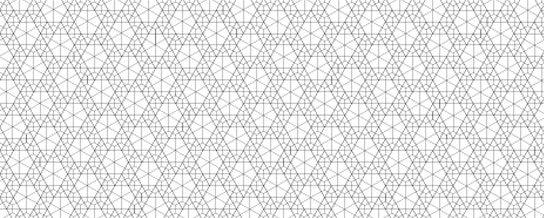Carsten Nicolai: Gridlocked
Carsten Nicolai is a co-founder of Raster-Noton Archiv Fur Ton und Nichtton (Raster-Noton Archive for […]

Carsten Nicolai: Gridlocked
Carsten Nicolai is a co-founder of Raster-Noton Archiv Fur Ton und Nichtton (Raster-Noton Archive for […]

Carsten Nicolai is a co-founder of Raster-Noton Archiv Fur Ton und Nichtton (Raster-Noton Archive for Sound and Non-Sound), the imprint behind the Clear and 20’ to 2000 series. The former was an attempt to release music without anything but the music and the format it was carried on (packaged in clear casings with as little text as possible); the latter compiled a single 20-minute CD each month in the run up to the millennium. Nicolai is also a visual artist, whose sculptures, drawings, and conceptual installations have appeared around the world, including the Venice Biennale and Berlin’s Neue Nationalgalerie.
His new book, Grid Index, is a “visual dictionary on two dimensional grids and geometric tilings” that lifts inspiration from art, architecture, and scientific papers. Sometimes austere and often beautiful, the collection feels like an “arty” visual counterpart to the minimal electronic music he records under the Noto and alva.noto monikers. We talked with Nicolai about his lexicon of patterns and grid systems, which he describes as a functional tool, reference book, and practical resource.
XLR8R: What do you see as the function of Grid Index?
Carsten Nicolai:Grid Index was produced for myself, as an archive—a source book where I can just go and look when I’m searching for a specific grid for something like an architectural project or for design issues. I thought it should be published because it’s a massive work and a beautiful collection. It’s the first book, as far as I know, that tries to categorize and to make a visual example of grids. I see it as a kind of scientific publication. I hope designers, architects, and mathematicians can get some use out of it as well.
What are you saying or hoping to articulate with the book?
I hope it becomes a foundation. If you need a grid or if you want to know more about grids or make your own grids, you can use things out of this book.
Is Grid Index a design for living? Are such levels of order, regulation, or neatness deliberately reflected elsewhere in your life?
Um, maybe not. It’s really, for me, a tool rather than a design book. It’s maybe a bit confusing because Gestalten publishes many books on the edge of architecture and design and art. I like that it shares all these areas a little bit but it’s much more about being a source, like the tafelwerk we were given at school that had all the logarithm numbers before pocket calculators, all the basic formulas that you needed to calculate things. It’s a dream that everybody would want to have this book on their shelf and use it every day or every week or every month—that it becomes like a school book.
Grid Index is accompanied by a CD of the book’s grids and patterns. What do you hope people will do with these images?
I hope people use it. Copyright is quite flexible in that people can use it for personal use and people can create things. I hope that this CD gives many elements to play with, to start thinking about patterns in a different way, to start a discussion about ideas of patterns, and to be aware more of how we use patterns in our daily life.
You’ve previously worked as a gardener. In what way has this impacted your subsequent work?
I worked as a gardener and studied landscape design, and I think this has been very influential for me. Nature is still a huge, huge inspiration. When you look at Grid Index, you can see that many of these patterns are basically “inside of nature.” Many more complex patterns are in life organizations or inside the organization of lifeforms; they are part of the foundation of our life. Mathematics is basically a part of nature.
Grid Index is out this month via Gestalten.

